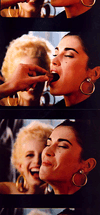During Peter Kubelka’s engaging, humorous, and inspiring presentation (and screening of his latest film), he reinforced several concepts and overarching theories that have fueled his personal philosophy and his craft. The first is humankind’s primordial nature as hunter and gatherer, and that as a filmmaker, Kubelka adapts to this primitive instinct though his penchant for collecting and assembling found objects and re-purposing them into “new” art: recycled sound bites, film excerpts, and even discarded outtakes. The second is the filmmaker’s societal role as that of an archaeologist, examining the found artifacts of human history and re-interpreting them to ensure continued, modern day relevance. In essence, the filmmaker is entrusted with a cumulative (and collective) cultural legacy. The third is that film plays at 24 frames per second and is therefore, capable of conveying 24 separate images and 24 separate sounds every second. Traditional filmmaking does not exploit this unique opportunity to deliver information so purely and compactly. Therefore, because of the filmmaker’s active, hands-on involvement in the gathering, assembling, interpretation, and distillation of the material in order to maximize the amount of information presented for a given footage, Kubelka strongly believes that film is a unique medium that should not be transferred to another medium, like DVD or video. Like other forms of art, film requires physical manipulation – a human imprint – in order to have social relevance.
Dichtung und Wahrheit (Truth and Poetry), 2003
Assembled from recurring outtakes from several commercial shoots, Dichtung und Wahrheit ingeniously captures the contrast between the moments before filming to the precise instance at which the actor’s come “on” and transform from mundane visual “objects” (the film leaders and scraps that invariably end up on the cutting room floor) into figurative works of “art” (the material that is used in the finished product) before the camera. During the Q&A session, Kubelka referred to the underlying goal of advertisement as exaggerated representations of false paradise, humorously noting that in the film, grooming serves as a surrogate display of masculinity, chocolate consumption as a pseudo-orgasmic experience, and shiny, waxed floors as the pathway to the light of Heaven. Within the context of using only found footage played in successive repetition, Kubelka, in essence, innovatively (and humorously) traces the entire gamut of the human cycle through subtle modulations in the performance of the trivial – from attraction, to sexuality, to procreation, and even into the afterlife – and in the process, illustrates a practical application for his all-encompassing social theory on the role and raison d’être of the filmmaker.
Mosiak im Vertrauen, 1954/55
Kubelka’s first feature Mosiak im Vertrauen presents a curious disjunction, yet achieves an integral cohesion between image and sound as seemingly mundane found footage that depict interpersonal episodes of flirtation, courtship, and break-up play out against a series of non-corresponding audio excerpts that coexist independently of the visual, but nevertheless, reveal similar intrinsic behavioral patterns of conflict and desire. Through the discrete layering of aural and visual stimuli, Kubelka creates a fascinating, thematically dense exposition on the essential interactions that invariably define the nature of human relationships.
Schwechater, 1958
Although not listed on the program, Kubelka also included a screening of his short film masterwork, Schwechater, an ingeniously (albeit irreverently) conceived – but never commercially aired – promotional piece that was commissioned by the Austrian brewery (after which, Kubelka jokingly adds, he was forced to leave the country and eventually settled in New York). Given free reign to film the commercial as he chose with the sole provision that he maximize the number of reinforcing shots of people enjoying a glass of beer within the one minute planned commercial spot, Kubelka concocts a maddeningly fractured montage of strobic, repeated subliminal images of casual beer drinking with intermittently punctuating shocks of color and frenetic white noise to convey the self-indulgent consumer message. Visually dense, structurally innovative, and idiosyncratically offbeat, the film is a delirious and sensorially revitalizing display of novel cinematic syntax and an exhilarating ode to conspicuous consumption.
© Acquarello 2004. All rights reserved.
